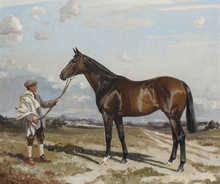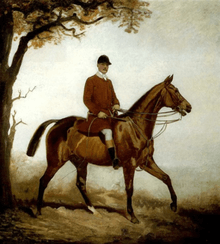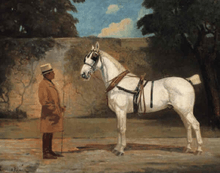Lynwood Palmer
James Lynwood Palmer (1868–1941) was an English painter who specialised in painting race-horses, his characteristic style showing them as nervous and highly-strung, often depicted within a background of a dramatic landscape. His success as a leading equestrian portrait painter of the first half of the twentieth century is represented by around eight hundred paintings that were commissioned by clients,[2] almost exclusively from private patrons, who included: William Cavendish-Bentinck, 6th Duke of Portland (1857–1943) (notably The Duke of Portland's stallions at Welbeck Stud (1900)[3]), Daisy Greville, Countess of Warwick (1861–1938) and King George V (1865–1936).[4][5][5] He rarely exhibited his work to the public.[note 1]




Origins
He was born in 1868 at Market Rasen in Lincolnshire, the third son and the youngest of eight children of Rev. George Thomas Palmer (1836–1908)[6] and Anna Frances Blair. His father, a former student at Peterhouse, Cambridge University.[7] was vicar of Linwood in Lincolnshire from 1861 to 1869 who in 1863 is recorded as a member of the Lincoln Diocesan Architectural Society[8] and later became an honorary canon of Rochester Cathedral (1890 to 1908) in Kent.[9] His older brother Charles Jasper was also an ordained minister.[7]
Lynwood Palmer's childhood was spent in London where his father took the living at St.James, Notting Hill Gate and from 1875 at St Mary's, Stoke Newington.He was educated at King's College School, and was destined by his father for a career in Law or in the Foreign Office. Palmer was not interested in such a course preferring horses and art at which he showed aptitude.[2]
Early career
In 1884, aged 17, Palmer left school without his parents blessing and emigrated to Canada where he worked with horses on cattle ranches, as a hansom cab master and show jumper. His involvement in horse shows in Toronto, and from 1892 in New York provided him with contacts and developed his skill in sketching horses.[4] According to Lyllyan Baldwin (1933)[note 2]
- "The first public success in his artistic career was perhaps that which came through the illustrations of an American catalogue of a sale of horses. The drawings received great praise and resulted in a number of commissions".[10]
Palmer spent some years in the 1890s supplementing his artistic income in employment as a cab master. At this time Palmer showed great interest in carriage driving which lead to commissions from Alfred Vanderbilt and Ambrose Clark and an increasing number of commissions for private clients and periodicals that included The American Carriage Monthly (1893)[11] Although he had no formal training he developed an affinity for drawing and painting horses of all types from hunting horses to carriage horses and race horses. He remained in North America for 11 years and found there several patrons who admired his style of painting and purchased his works, including Marshall Field I (1834–1906), the American entrepreneur and founder of Marshall Field and Company, the Chicago-based department stores.[12]
In 1895 Palmer returned to Europe with a nucleus of work to his credit, mostly from anglophile Americans[2] A short stay followed with a relative in Co. Offaly where he garnered new contacts and future patrons that included T. K. Laidlaw before he and his wife Lydia returned to England where they eventually settled in 1911 at the 16th Century White House at Sutton near Heston, Middlesex.[2] A confident, well dressed man he was at home with all types of horses and self possessed enough to move smoothly between his aristocratic clientele. He prospered attributing his success to clients that included: the Earl of Derby, Lord Lonsdale, the Duke of Portland and most importantly Edward VII for whom he painted his Derby Stakes winner Minoru in 1909. It established him as a major painter of racehorses, a relatively small field that included his friend Alfred Munnings, Emile Adam, Lionel Edwards and Raoul Millais. Palmer created a niche for himself and his style and subject matter rarely deviated for the remainder of his career.[2]
Knowledge of Horses
Palmer had a deserved reputation for his ability to treat lame horses, no doubt learnt as a result of his training as a cab master. In 1911 the Home Secretary, Reginald Mckenna, concerned at the injury rate of police horses on city cobbles asked Palmer to provide advice on the treatment of horses hooves.[13] Subsequently, some trainers would seek Palmer's advice. In his latter years he frequented Hounslow Barracks, the regimental mess of the 17/21 Lancers where his advice was sought and given.[14]
Palmer was also a judge at the International Horse Show at Olympia in 1921 but had been involved in its organisation since its inception in 1907. He designed a series of publicity postcards in pre war years.[4]
As an asthmatic Palmer was deemed not fit for military service during World War I, offering his skills for the service of the nation by managing a 750 horse stud for the Royal Mail.[2]
Racehorse paintings
Palmer's notoriety as an equine artist is largely based on his paintings of racehorses for an aristocratic, wealthy clientele that were united by wealth and interests. Palmer and Munnings became the preferred choice of this set when it came to painting their equine champions. Most of the commissions were for racehorses on the flat although Palmer painted seven winners of The Grand National.
Palmer painted winners of all the English and Irish classics and many Group winners beside. These included champion horses such as: the Earl Of Derby's Swynford, winner of the Eclipse Stakes and the St Leger, Tranquil, a success in the fillies classic, the 1,000 Guineas in 1923 and Hyperion, painted in 1933 after the colt won both the Derby and St Leger, Aboyeur, winner of the Suffragette Derby in 1913, Royal Lancer, owned by Earl Lonsdale and winner of the St Leger in 1922, Lord Woolavington's Derby winner Coronach, the undefeated The Tetrarch owned by Sir Hugh McCalmont and voted by the British National Horseracing Museum as the best English trained two-year old of the 20th Century, Gainsborough who in 1918 won the English Triple Crown and the Ascot Gold Cup for Lady Douglas, the first woman to own a classics winner and the filly Golden Corn, winner of the July Cup in 1923 and owned by Marshall Field III grandson of Palmer's early patron.[2] The style is always the same with non-specific, featureless backgrounds so that the eye always focuses on the horse.
Carriage driving paintings
Palmer had a passion for carriage driving and was frequently seen driving his "beautifully maintained" coach and Four-in-hand.[4] Some of his earliest paintings are of carriage driving in the United States and Canada. One of Palmer's first major commissions for August Belmont II , now at The Schwarz Gallery in Philadelphia features a four-in-hand horse carriage being driven along Ocean Drive, Newport, Rhode Island. Another major client Alfred Vanderbilt had moved to England by 1904 where he purchased fifty trotting horses, together with a team of carrige greys and two carriages which he based near Palmer at Kingsbury. Palmer painted at least four commissions for Vanderbilt before the latter returned to the United States in 1914.[15] Other carriage themed paintings for Ambrose Clark and Lady Warwick were commissioned. One of his most important patrons of the post War years was Lord Woolavington, a collector of English sporting paintings for whom Palmer produced two paintings of carriage horses (and several racehorses besides).
Technique
Lynwood Palmer possessed a retentive visual memory for the appearance of a horse. Invariably he made sketches from life, out of doors, if possible. He worked quickly and quietly trying to capture the character of the horse. In 1927 he explained his work as follows:
- "The secret of painting race-horses lies in quickness. Their movements are so alert, they are so full of nervous energy, that the artist has to have a hand like a streak of lightning to catch the pose while it lasts".[5]
His paintings of race horses, nearly all on commission, are in oil on canvas. The background is usually non -specific and the horse is centre stage. Palmer's knowledge of the anatomy of a horse was based on practical knowledge but he had studied George Stubbs Anatomy of a Horse in detail according to one of his pupils.[16] His use of colour was limited and he did not block applying colours directly to the canvas to produce the iridescent sheen which are a feature of his paintings. Palmer's figures are often one dimensional.[2][note 3] He was primarily interested in making a true likeness of the horse against a harmonious background. He did not show any interest in wider fields staying firmly in the English tradition of earlier racehorse artists such as: Harry Hall, John Frederick Herring Sr. and his son John Frederick Herring Jr. Once his style was established it did not change.[2] His success as an artist was largely derived through his ability to infuse into his expert draughtsmanship his thorough and first-hand understanding of the characteristics of the animals he was painting.[4]
Personal life and character
He was "always elegantly dressed, and with impeccable manners, he was hugely popular, especially, it was rumoured, with the wives of some of his patrons".[4] His appearance was that of a sporting gentlemen of an earlier epoch. Palmer was quiet, gentlemanly, thoughtful, amusing and respectful.[2] He received a serious injury when kicked by one of his equine subjects close to the heart, which affected him considerably in his later years.
In 1895 whilst residing in the United States he met and married Lydia Frohawk of Dereham, Norfolk, the daughter of a local landowner. Her brother was Frederick William Frohawk (1861–1946),an established zoological artist and lepidopterist. The marriage lasted until his death at Heston on 22 June 1941, his wife dying in 1942[2]
In his will Palmer left personal possessions including his riding crop and glasses to his housekeeper Mary Cox, which items were sold at auction by Sotheby's on 1 November 2006.[9] His long standing friend Hugh McCausland was left the bulk of his estate. Palmer's studio later became a dance hall and his house was demolished in 1964.[17]
Further reading
- Fountain, Robert & Kennedy, Neil, Lynwood Palmer, 1868–1941, Equestrian Artist, Whip and Horseman Palette press, UK 2009 ISBN 978-0-9556138-3-8
- Baldwin, Lyllyan, Lynwood Palmer – Painter of Horses, Apollo Magazine, Vol.17, No:101, May 1933, pp. 175–180
Illustrations of works
Notes
- An exhibition of his work was held at the Carlton Gallery, London, in 1898
- The author was Palmer's secretary.
- Algernon Talmage an impressionist painter of the period is responsible for some of the figures in these paintings. In 1925 Lynwood Palmer was painted by Algernon Talmage R.A. seated astride a carriage. The painting is in private hands.
| Wikimedia Commons has media related to James Lynwood Palmer. |
References
- http://www.horseracinghistory.co.uk/hrho/action/viewDocument?id=1215
- Fountain, Robert & Kennedy, Neil, Lynwood Palmer, 1868–1941, Equestrian Artist, Whip and Horseman, Palette press, UK 2009
- http://www.artnet.com/artists/james-lynwood-palmer/the-duke-of-portlands-stallions-at-welbeck-stud-KaEiDBqT1D9X1rBsJsKucA2 See image
- http://www.sallymitchell.com/products/14140/lynwood-palmer-equestrian-artist-whip-and-horseman-equestrian-art-book15
- https://www.royalcollection.org.uk/collection/402434/limelight
- https://www.bonhams.com/auctions/11932/lot/85/
- Alumni Cantabrigienses: A Biographical List of All Known Students ..., Volume 2 edited by John Venn
- Reports and papers of the architectural and archaeological societies By Associated Architectural Societies, 1863, p.vi
- Rasen Horse Artist, Market Rasen Mail, 27 October 2006'
- Baldwin, Lyllyan, Lynwood Palmer – Painter of Horses, Apollo, Vol.17, No:101, May 1933, pp.175–6
- American carriage Monthly, 25 March 1893.
- Toledo Club Newsletter, September 2011, p.19 The Toledo Club Art Collection: "his list of wealthy American clients included the Vanderbilts and Marshall Field"
- Lynwood Palmer, Feet And Shoeing In My Opinion by W.E. Lyon, 1928
- Letter to The British Racehorse 1977
- Hugh McCausland Lynwood Palmer as a painter of the Road The Horse, Michaelmas 1943 p.10-13
- Fountain, Robert & Kennedy, Neil, Lynwood Palmer, 1868–1941, Equestrian Artist, Whip and Horseman, Chapter 11 on Technique
- http://hestonresidentsassociation.org/lynwood-palmer-and-the-master-robert , Heston Residents Association, Lynwood Palmer and the Master Robert Public House.